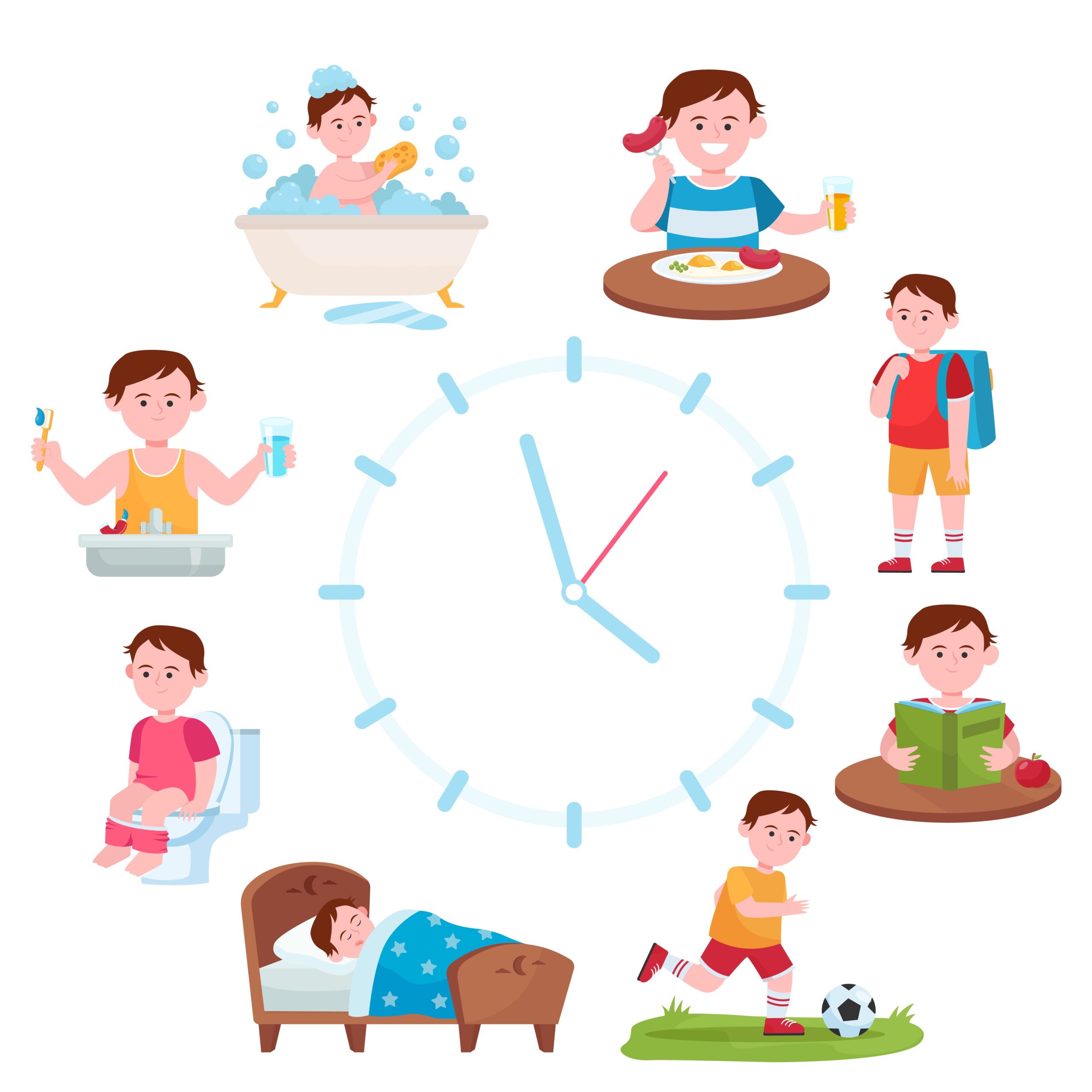Establishing a healthy and balanced routine for eating, playing, and sleeping is crucial for overall well-being and development, especially for young children. A well-structured routine can provide stability, promote healthy habits, and support optimal growth and cognitive function. In this essay, we will explore seven essential steps to help you establish an effective eat, play, and sleep routine for your child.
Step 1: Assess Current Habits and Create an Effective Eat Play Sleep Routine
Assessing the current habits of your child when it comes to eating, playing, and sleeping is a crucial first step in establishing an effective routineHere’s why this step is so important:
- Understanding Existing Patterns
Understanding the individual habits and preferences of each child in relation to eating, playing, and sleeping is crucial.. Building upon this knowledge, it becomes possible to establish a tailored regimen that addresses the unique needs of every child.
- Recognizing opportunities for growth
By evaluating existing practices, one can pinpoint potential areas that would benefit from enhancement or modification.
It allows you to recognize patterns that may be detrimental to your child’s well-being, such as irregular eating patterns, lack of physical activity, or difficulty falling asleep. By pinpointing these areas, you can take proactive steps to address them and create a more balanced and healthy routine.
- Recognizing Patterns and Triggers
Assessing current habits also helps you recognize patterns and triggers that may be influencing your child’s behaviors. For example, you may notice that they have difficulty concentrating during mealtimes or have trouble winding down before bedtime. By identifying these patterns, you can make necessary adjustments and create an environment that supports their optimal functioning.
- Tailoring the Routine
Understanding your child’s existing habits allows you to tailor the routine to their individual needs. By taking their preferences and habits into account, you can create a routine that is more likely to be embraced and followed consistently.
Step 2: Setting Realistic Goals

Setting realistic and achievable goals is a vital step when establishing an effective eat, play, and sleep routine for your child. By defining clear goals, you provide a roadmap for success and ensure that your efforts are focused and purposeful. Here’s why setting realistic goals is essential:
Considering Age, Individual Needs, and Family Dynamics
- When setting goals, it is essential to take into account the age, individual needs, and family dynamics of your child.
- . Consider their developmental stage, nutritional requirements, sleep patterns, and preferences. Additionally, consider the dynamics of your family, such as work schedules, commitments, and the availability of resources. By considering these factors, you can set goals that are realistic and aligned with your child’s needs and your family’s circumstances.
Balancing Ambition and Realism
While it’s important to aim high, it’s equally important to be realistic about what can be achieved within the given context. Set goals that challenge your child to grow and develop but are also within their capabilities. For example
Flexibility and Adaptability
It is important to keep in mind that goals may require adjustments as circumstances evolveChildren grow and develop, and their needs evolve. Stay open to revising and adapting the goals as necessary. Flexibility allows you to make modifications that better suit your child’s progress and ensure that the routine remains effective and sustainable.
Step 3: Designing a Schedule
Designing a schedule that incorporates dedicated time for eating, playing, and sleeping is a crucial step in establishing an effective eat, play, and sleep routine for your child. A well-structured schedule provides a sense of predictability and stability, which is beneficial for their physical and mental well-being. Here’s how you can create a schedule that supports your child’s needs:
Process of Creating a Schedule
- Assess your child’s current routine
Start by observing their natural patterns and noting the times when they are most alert, hungry, and tired.
- Determine the appropriate duration
Consider the recommended duration for eating, playing, and sleeping based on your child’s age. This will help you allocate the appropriate amount of time for each activity.
- Establish consistent meal times
Set regular meal times throughout the day to provide structure and promote healthy eating habits. Aim for three balanced meals and a few nutritious snacks in between.
- Allocate playtime
Dedicate specific periods for play and physical activity. This could include both structured activities, such as games or sports, as well as unstructured play where your child can engage in imaginative and creative play.
- Improves sleep quality
Following a consistent sleep routine enhances your child’s ability to regulate their internal body clock, facilitating easier sleep initiation and promoting a refreshed waking state. A well-rested child exhibits improved alertness, attentiveness, and emotional balance.
- Facilitates learning and development
A structured routine allows your child to engage in activities that promote cognitive, physical, and social development. It provides dedicated time for learning, exploration, and skill-building.
- Improves time management skills
Following a schedule teaches your child the importance of managing their time effectively, instilling valuable organizational skills that will benefit them in the future.
Step 4: Meal Planning and Nutritious Choices

Meal planning and making nutritious food choices are essential components of establishing an effective eat, play, and sleep routine for your child. Here’s why meal planning and nutritious choices are important and some tips to consider:
Importance of Planning Balanced Meals and Snacks
- Meeting nutritional needs: Children require a variety of nutrients for their growth and development. Planning balanced meals and snacks ensures they receive a wide range of vitamins, minerals, proteins, carbohydrates, and healthy fats necessary for their optimal health.
- Energy and concentration: Proper nutrition is crucial for sustaining energy levels and promoting optimal cognitive function. Balanced meals and snacks provide the necessary fuel to support your child’s active lifestyle, helping them stay focused and engaged throughout the day.
- Establishing healthy eating habits: By introducing nutritious foods early on and incorporating them into their routine, you help your child develop lifelong healthy eating habits.
Tips for Selecting Nutritious Foods
- Colorful and vibrant choices: Encourage your child to eat a rainbow of fruits and vegetables. Different colors indicate different nutrient profiles, so including a variety of colors ensures they receive a broad range of vitamins and minerals.
- Choose whole grains instead of refined grains: When it comes to selecting food, it is recommended to give priority to whole grain alternatives like whole wheat bread, brown rice, and whole grain pasta. These choices offer a higher amount of fiber, essential vitamins, and minerals, while also providing sustained energy throughout the day.
- Additionally, it is advisable to incorporate lean sources of protein into your diet, such as poultry, fish, beans, lentils, and tofu. Protein plays a crucial role in supporting growth, development, and muscle repair.
- Limit added sugars and processed foods: Minimize the intake of sugary drinks, processed snacks, and foods high in added sugars. Instead, offer healthier alternatives like fresh fruits, homemade snacks, and water as the primary beverage.
- Involve your child: Let your child participate in meal planning and preparation. This encourages their interest in food and makes them more likely to try new and nutritious options.
- Lead by example: When children witness their parents or caregivers practicing healthy behaviors, they are more inclined to adopt these habits themselves.
- Remember, creating a positive food environment and introducing variety in their diet is key.
- Consistency and gentle persistence can help expand their palate and foster a lifelong appreciation for nutritious choices.
- By incorporating these tips into your meal planning, you provide your child with a well-rounded and nourishing diet that supports their growth, development, and overall well-being.
Step 5: Encouraging Active Play
Encouraging active play is an integral part of establishing an effective eat, play, and sleep routine for your child. Physical activity not only contributes to their overall health and well-being but also promotes growth, development, and learning. Here’s why active play is important and some ideas for age-appropriate activities to incorporate:
Benefits of Physical Activity for Growth and Development
- Motor skill development: Active play helps children develop their gross motor skills, such as running, jumping, and throwing, as well as their fine motor skills through activities like drawing or building with blocks. These skills are essential for their physical coordination and future learning abilities.
- Cognitive development: Engaging in physical activity stimulates brain function, leading to improved cognitive abilities such as attention, memory, and problem-solving. It fosters the creation of neural connections, supporting optimal brain development.
- Emotional well-being: Engaging in active play provides children with a means to release energy, alleviate stress, and uplift their mood.
- Social interaction: Participating in active play offers children opportunities to interact socially with peers, siblings, or caregivers, promoting the development of important social skills.. It promotes teamwork, cooperation, and the development of social skills.
Ideas for Age-Appropriate Activities
- Toddlers (1-3 years): Encourage free play in safe environments like playgrounds, where they can climb, slide, and explore. Provide opportunities for dancing, crawling, and playing with age-appropriate toys that promote movement.
- Preschoolers (3-5 years): Engage in activities such as tag, hide-and-seek, or ball games that involve running, jumping, and throwing. Encourage tricycle or bicycle riding, swimming, or simple yoga poses to promote balance and coordination.
- School-age children (6-12 years): Encourage structured activities like organized sports, martial arts, or dance classes. Outdoor activities such as biking, hiking, or playing catch can also be incorporated. Encourage active play with friends, promoting team sports and cooperative games.
- Family activities: Plan family outings that involve physical activity, such as nature walks, hiking trails, or bike rides. Engage in interactive games like scavenger hunts, relay races, or family-friendly workouts that promote movement for everyone.
- Remember to prioritize safety during physical activities. Provide appropriate protective gear, supervise young children, and choose age-appropriate activities that match their abilities.
Step 6: Creating a Soothing Bedtime Routine

Creating a soothing bedtime routine is crucial for establishing an effective eat, play, and sleep routine for your child.Here’s why a soothing bedtime routine is important and some suggestions for activities to incorporate:
Significance of Establishing a Calming Routine Before Bedtime:
- Consistent sleep cues: A bedtime routine provides consistent cues that signal to your child’s body that it’s time to transition from the active part of the day to a more relaxed state.
- Relaxation and stress reduction: Engaging in calming activities before bedtime helps your child relax and unwind. It reduces stress and anxiety, allowing them to transition into a more peaceful and restful sleep.
- Improved sleep quality: Consistently following a bedtime routine has been linked to enhanced sleep quality. By following a consistent sequence of activities, you establish a familiar and comforting environment that promotes deeper and more restorative sleep.
Suggestions for Activities to Help Relax and Prepare for Sleep
- Establish a consistent bedtime: Set a regular bedtime that allows for an appropriate amount of sleep based on your child’s age. Consistency in the timing of sleep helps regulate their body’s internal clock
- Create a peaceful environment: Dim the lights, close curtains or blinds, and create a soothing atmosphere in your child’s bedroom. Consider using soft lighting, calming colors, and a comfortable sleep environment to enhance relaxation.
- Limit stimulating activities: Avoid activities that can be overstimulating or cause excitement before bedtime. This includes avoiding screen time, intense physical play, or engaging in stimulating conversations.
- Use soothing music or white noise: Playing soft, soothing music or using white noise machines can create a peaceful ambiance that helps drown out distracting noises and promotes relaxation.
Step 7: Consistency and Flexibility

Maintaining consistency in your eat, play, and sleep routine is vital for its effectiveness. However, it’s equally important to allow flexibility to accommodate unforeseen circumstances and adapt the routine as your child grows and their needs evolve Here’s why consistency and flexibility are essential for establishing and sustaining an effective routine:
The Significance of Maintaining Consistency
- Promoting Predictability and Security
Consistency offers a sense of predictability and security to your child. By adhering to consistent meal, play, and sleep times, you regulate their internal clock, optimizing their natural rhythms and fostering overall well-being. It establishes a healthy equilibrium between activity and rest.
- Establishing Behavioral Expectations
A consistent routine sets clear expectations for behavior, aiding your child in understanding the boundaries and structure of their day. This promotes stability and enhances behavior management.
- Enhancing Sleep Quality
Maintaining consistent sleep and wake times contributes to improved sleep quality and overall sleep hygiene. A regular sleep routine synchronizes the body’s natural sleep-wake cycle, resulting in better sleep duration and quality.
Benefits of Allowing Flexibility
- Adapting to Changing Needs
As your child grows, their needs and preferences evolve This ensures that the routine remains suitable and effective for their age and developmental stage.
- Addressing Unforeseen Circumstances
Life’s unpredictability may occasionally disrupt the routine due to unforeseen events. Allowing flexibility helps you navigate these situations with minimal stress and maintain a sense of balance.
- Acknowledging Individual Differences
Each child is unique, and their needs may vary from day to day. Granting flexibility in the routine allows for customization based on their individual requirements.Flexibility allows you to tailor the routine to meet their individual requirements, taking into account factors such as growth spurts, developmental milestones, or illness.
- Promoting autonomy and independence
Allowing flexibility within the routine empowers your child to make choices and take ownership of their actions. It encourages them to develop decision-making skills and a sense of responsibility.
- Finding the Balance
Maintaining a harmonious blend of consistency and flexibility is crucial. While it is essential to adhere to the established routine whenever feasible, there may be instances where modifications are required. Here are some guidelines for achieving this equilibrium:
- Stick to the core elements
Identify the core components of the routine that are non-negotiable and maintain consistency in those areas, such as meal times and bedtime routines.
- Plan for contingencies
Anticipate potential disruptions and have contingency plans in place. This might involve having backup meal options, adjusting nap times when needed, or adapting activities to fit the circumstances.
- Communicate and involve your child
As your child grows, involve them in the decision-making process and communicate the reasons behind any necessary adjustments. This fosters their understanding and cooperation.
- Monitor and reassess
Regularly assess the effectiveness of the routine and make adjustments as needed. Pay attention to your child’s changing needs and preferences, and be open to adapting the routine accordingly.
By implementing these 7 steps and incorporating them into your daily life, you provide your child with a solid foundation for healthy habits and optimal development.













